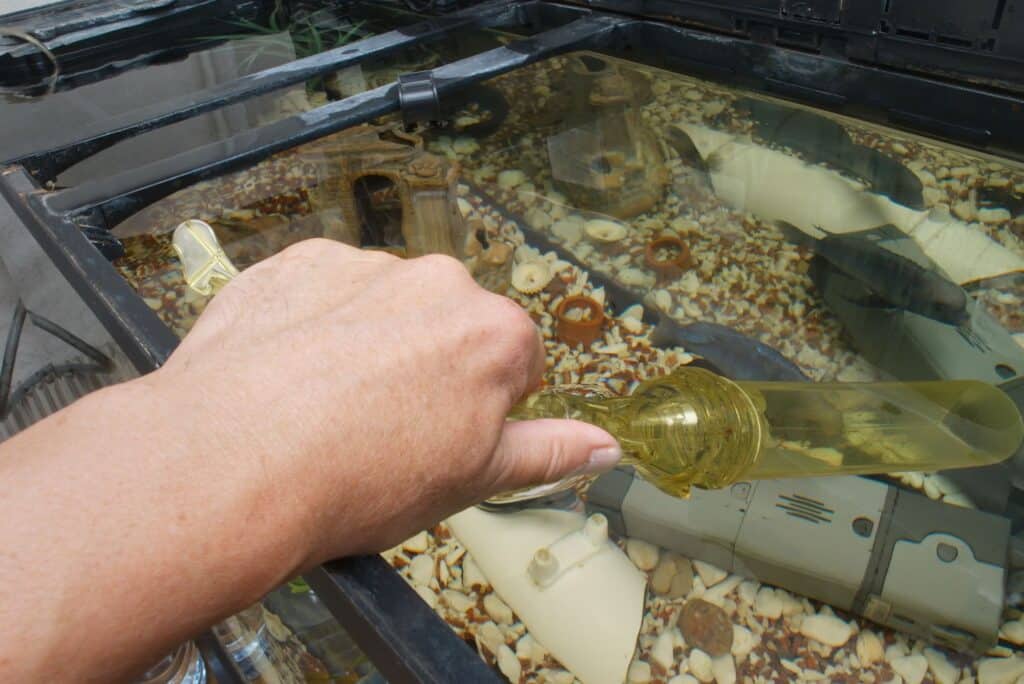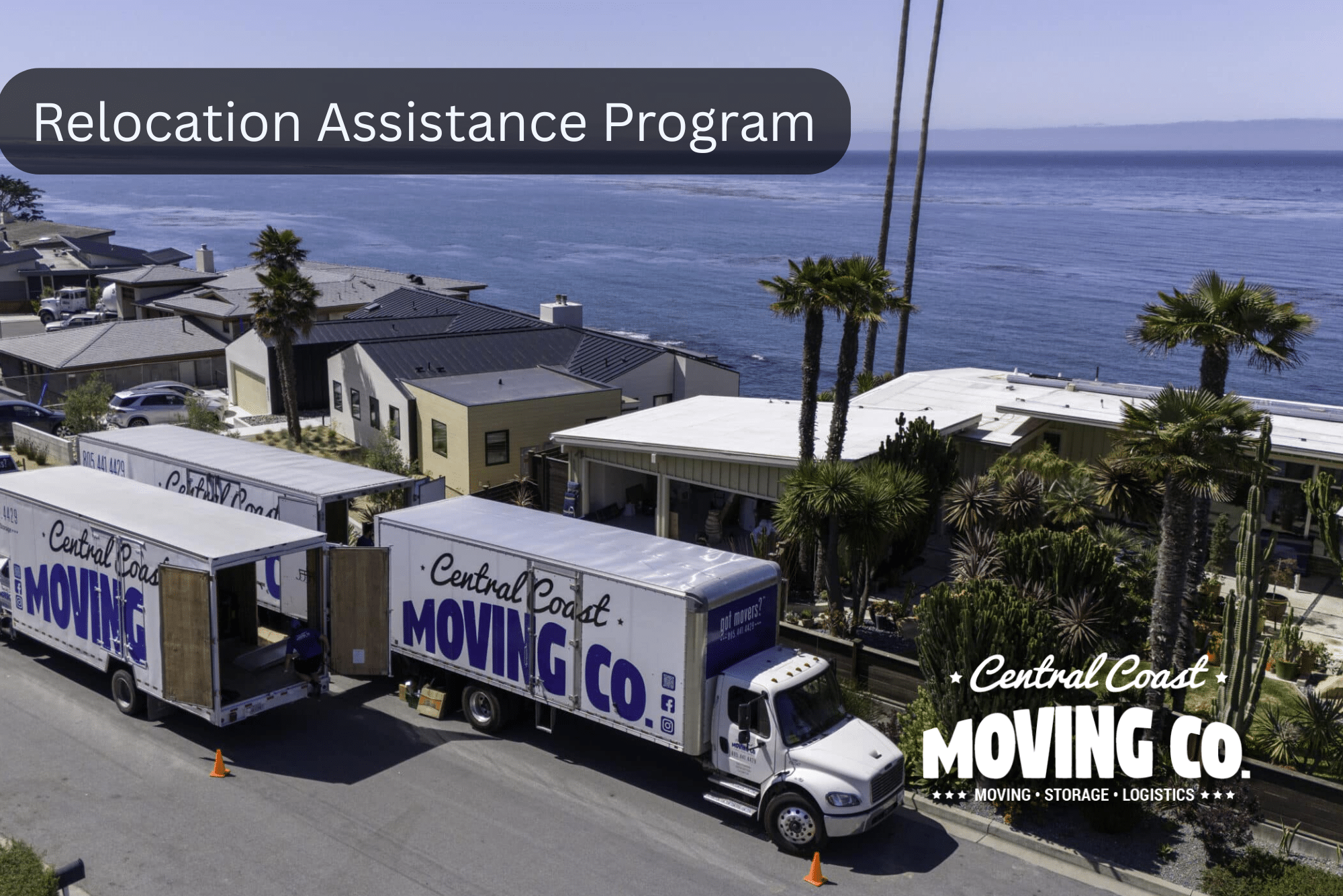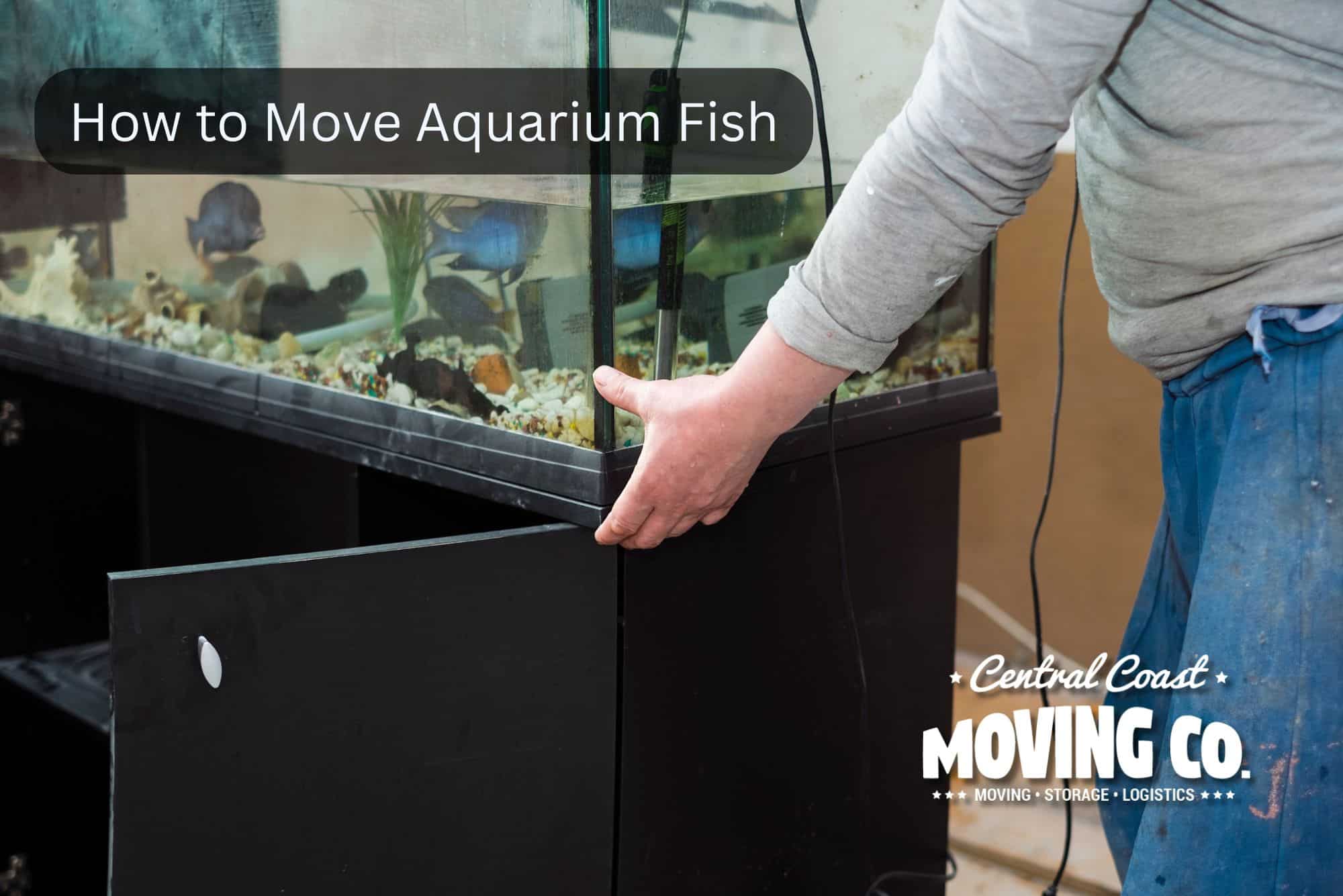Moving an aquarium is different from moving any other household item. You are transporting a living ecosystem, and fish are animals that require special care and handling during a move. With the right plan and a calm pace, you can relocate your fish and tank safely whether you are going across town or across the state. This guide shows you how to move aquarium fish without stress, preserves your water quality, and helps your fish settle quickly in the new home.
Quick answer – To move aquarium fish safely, prepare a week in advance, fast fish for about twenty four hours before travel, save as much tank water as practical, keep filter media wet in tank water, bag fish individually with roughly one third water and two thirds air or use oxygen, place bags inside an insulated cooler, never lift the tank with water or substrate, set up promptly at the new home, acclimate slowly using the floating or drip method, then wait about twenty four hours before feeding again.
The most important thing is to preserve and transport as much of the existing water and the animals as possible. Another important thing is to minimize stress and maintain the biological balance for the animals during the move.
Why moving an aquarium is different
An aquarium is a living filter with beneficial bacteria that process waste, and it also houses animals like fish that require special handling during a move. A move disturbs that balance. Your goal is to protect the biofilter, keep temperature stable, and reduce stress while everything travels.
Saving a large portion of the original water, keeping filter sponges and media wet in tank water, and getting the system running quickly at the destination all shorten the time before the tank stabilizes again. When preparing to move, remember that hiding places such as rocks or decor in the aquarium can make it harder to catch the animals, so inspect or remove these structures as needed. Expect brief cloudiness or small ammonia and nitrite spikes after a move and monitor closely.
The supply list you will actually use
Gather supplies a week before the move so you can test and label everything.
- Clean five gallon buckets or lidded totes for water, substrate, and décor
- Fish bags and rubber bands, or food safe containers with lids
- Insulated cooler, Styrofoam box or foam shipper to hold bagged fish
- Battery powered air pump and airstones for longer trips or warm days
- Siphon hose and towels
- Water conditioner and test kits
- Nets, small catching box, and a colander for substrate
- Bubble wrap or blankets for glass
- Permanent marker and painter’s tape for labeling cords and equipment
Make sure all containers used for transporting fish have a secure cover to prevent spills and keep fish safe and calm during transit.
Make sure you assemble these pieces a week in advance, saving as much water as possible in buckets with snap on lids, and using a battery air pump when needed.
Pre move preparation
Seven to ten days before the move
- Perform a light filter clean without disturbing biological media
- Do a partial water change and note your baseline parameters
- Check access at the new home for tank size, stands, and power outlets
- Mix or condition new water at the destination if needed
- Ensure transport containers have enough room for fish to swim and access oxygen
- If you must move the tank or containers with water, only fill them half full to prevent spills and damage
One to two days before the move
Stop feeding for about twenty four to forty eight hours. Fasting reduces waste and ammonia during transport which keeps water cleaner in bags and buckets. Several aquarium authorities recommend this step, and Practical Fishkeeping notes a minimum of twenty four hours.
Catching and packing fish the right way
How to net and contain fish with minimal stress
Move décor out first to remove hiding spots, then drain part of the water so fish are easier to net. For small to medium fish, pack them individually in fish bags. Fill each bag with roughly one third water and two thirds air or ask your local store to add oxygen to the bag. Double bag to prevent punctures and lay the bags on their sides in an insulated cooler to keep light low and temperature steady.
For larger fish, use a bucket as a transport vessel, as it provides enough space for the fish to swim comfortably and access sufficient oxygen. Always use a secure cover or lid on the bucket to prevent escapes and keep the fish calm. These ratios and techniques come straight from industry guidance.
How to transport aquarium fish for short moves
For moves under an hour, bagging is preferred and keeps stress low. Keep bags closed and in the dark in a cooler. LiveAquaria recommends bagging specimens individually for short moves and using a cooler to maintain temperature. When packing, ensure each fish has enough room to swim comfortably in its transport container.
How to transport fish when moving to another house
If the trip will be several hours, bag fish individually with oxygen or use a lidded container with a battery air pump. Keep containers out of direct sun and away from heaters or vents.
How to transport fish in a car
Place a cooler on a level car floor or secure it to keep it from sliding. Avoid opening the cooler until you arrive so you do not lose heat. Before moving the tank, remove the sand substrate and place it in a sealed container with some tank water to preserve beneficial bacteria; avoid letting it dry out during transport. Use a dark, insulated box that remains closed during travel to reduce stress and retain temperature.
When packing equipment, allow heaters to cool completely before packing them to prevent damage or accidents.
Moving the empty tank and equipment
Never lift or transport a tank with water or substrate inside. This can damage seams and glass. Drain the tank completely, remove substrate and décor, and pack them separately. Keep filter media and sponges wet in tank water to preserve beneficial bacteria.
Wrap the tank in blankets and keep fragile items like lids inside the tank for protection. Load the tank securely so it cannot slide or tip. Verify that the stand at the new location is level and that the floor can support the full weight once filled.
Packing the fish tank for safe transport
Packing your fish tank properly is one of the most important things you can do to ensure a stress free move for your fish and other tank inhabitants. Start by carefully wrapping the empty tank in bubble wrap or thick blankets to protect the glass from scratches and accidental bumps. For added security, place the wrapped tank inside a sturdy box or cushion it with additional padding on all sides.
When it comes to transporting tank water, live plants, and other equipment, use water tight containers or buckets with snap on lids. This prevents spills and keeps your tank water clean and ready for reassembly. For larger tanks, sturdy buckets or lidded containers are essential to handle the extra weight and volume. Always verify that lids are snapped on tightly and containers are leak-proof before loading them into your car.
Remove all decorations, rocks, and other equipment from the tank before packing. Place these items in separate containers or wrap them in paper towels or bubble wrap to prevent damage during transport.
Live plants should be kept moist. Wrap their roots in damp paper towels and place them in water tight bags or containers to keep them healthy until you reach your new location.
Equipment
Don’t forget to pack essential equipment such as air pumps, filters, and heaters. Keep these items together in a clearly labeled box so you can access them quickly when setting up your tank in the new home. Double check that all equipment is dry and secure to avoid any electrical issues later.
By taking the time to pack your fish tank, plants, and equipment with care, you’ll minimize the risk of damage and ensure a smooth, stress free transition for your aquatic pets.
Reassembly and acclimation in the new home

Set the stand, level it, and place the tank. Add substrate, décor, and equipment but leave everything unplugged. Pour saved water back into the tank to about halfway, then add the remaining saved water. Top off with conditioned water to reach your target level. Check and adjust the heater to ensure the water temperature is stable before plugging in other equipment. Keep lights off for the first few hours to minimize stress. Do not feed fish immediately after the move. Aqueon recommends waiting about twenty four hours before feeding, and Practical Fishkeeping offers the same advice.
How to acclimate fish after transport
Fish and equipment that were carefully transported now need to be acclimated to the new environment. Use the floating method or the drip method. The floating method lets bag temperature match the tank, then you add small amounts of tank water to the bag at intervals before release. The drip method uses airline tubing to slowly drip tank water into the holding container for a more precise transition.
Once your fish and tank are set up, you can begin unpacking the rest of your belongings.
Expect a short stabilization period
Even established tanks often experience brief new tank syndrome after a move because colonies of nitrifying bacteria were disturbed. Test for ammonia and nitrite during the first week and be ready to make water changes or add carbon as needed.
Final check: Ensuring a smooth transition for your fish
Before you hit the road, it’s time for a final check to make sure your fish and tank inhabitants are set up for a safe, stress free journey. Start by verifying that all containers, whether buckets, bags, or water tight boxes, are properly filled with tank water and securely closed. Double check that live plants are packed with enough moisture to prevent them from drying out during transport.
Review your moving plan and confirm that all essential supplies are packed and easy to access. This includes food, water conditioners, chemicals, heaters, filters, air pumps, and any other equipment you’ll need to get your fish tank up and running at the new location. Make sure you have enough buckets and containers for all your tank water, rocks, and decorations.
Check the temperature and oxygen levels in your transport containers. If you’re using battery-powered air pumps or airstones, ensure they’re running and have fresh batteries. For longer trips, monitor the temperature inside coolers or containers to keep your fish comfortable and safe.
Take a moment to review your checklist and confirm that nothing has been left behind. Completing this final review helps ensure your fish will survive the move and thrive in their new home. Remember, patience and careful planning are the most important things you can bring to the process. By staying organized and attentive, you’ll help your fish and plants settle in quickly and enjoy a smooth transition to their new tank.
Long distance moves and overnight plans
How to move fish long distance
For trips lasting many hours or overnight, plan like a shipper. Use oxygen filled bags for small to medium fish, or use lidded containers with air stones powered by a battery pump. For long-distance or international moves, you also have the option to ship fish using specialized pet transportation or courier services that handle live animals.
Keep media in tank water to preserve bacteria, and save as much of the original water as practical to shorten cycle time at the destination. Aqueon and LiveAquaria outline these approaches and note that saving water reduces the time before your aquarium rebalances.
If moving across state lines, research species rules. The Lacey Act restricts transport of species listed as injurious wildlife and requires permits for interstate transport of those species. Check federal and state agencies when you are unsure about a particular fish.
If you must re home fish or plants, consider captive bred options when you restock. Conservation reporting has highlighted how heavy demand for some marine species can pressure wild populations, so it is wise to choose responsibly sourced livestock when possible.
Common mistakes to avoid
- Feeding within a day of departure which raises waste and ammonia in travel water
- Moving the tank with water or gravel inside which risks cracked seams
- Scrubbing filter media in tap water which kills beneficial bacteria
- Placing bags in direct sun or near heat which spikes temperature
- Rushing acclimation or turning lights on immediately at the new home
- Forgetting to test for ammonia and nitrite during the first week
Each of these missteps appears in expert moving guidance and can be avoided with a written plan.
When to hire professional help

Large glass tanks, custom stands, and reef systems often justify calling in help. A professional crew handles the heavy lifting while you focus on the livestock. Central Coast Moving trains crews to protect fragile items and can stage the move so your aquarium is the last item packed and the first item set at the destination. For homeowners in Arroyo Grande and nearby areas, our team can manage the logistics while you bag and acclimate fish at a comfortable pace.
Where We Work
Central Coast Moving provides aquarium moving in San Luis Obispo, serving Atascadero and nearby areas, with frequent local moves in Paso Robles and Pismo Beach. We also support regional relocations across the Central Coast for homeowners and renters.
Frequently asked questions
How do I transport aquarium fish in a car for a long distance
Use oxygen filled bags or lidded containers with a battery air pump. Keep containers insulated out of direct sun and avoid temperature swings. Plan for quick reassembly and acclimation on arrival.
How to move a fish tank to another house without losing fish
Fast fish for a day, save as much old water as practical, keep media wet, pack fish in bags or aerated containers, never move the tank with water, and set up immediately at the destination with slow acclimation. Wait about a day before feeding.
How much old water should I save
Save as much as you can reasonably carry. Guidance from Aqueon suggests roughly three quarters of the tank’s volume to reduce cycling time.
Is it safe to leave substrate slightly wet in the tank for a short move
Keep substrate wet to preserve bacteria, but do not move the tank with any weight or water inside. Scoop substrate into buckets with tank water instead.
When can I feed after the move
Give fish time to settle. Both Aqueon and Practical Fishkeeping recommend waiting about twenty four hours before feeding, then start lightly.
Let Central Coast Moving Handle the Heavy Lifting
Relocating an aquarium is one of the most delicate parts of moving, but with the right preparation and care, you can ensure that every fish, plant, and piece of equipment arrives safely. A successful move comes down to patience, planning, and protecting the small details that keep your aquatic ecosystem balanced.
Take the time to prepare your supplies, handle your fish calmly, and reestablish the tank carefully once you reach your new home. By following the steps in this guide, you’ll preserve the health of your fish and the stability of your aquarium, whether you’re making a quick move across San Luis Obispo or starting fresh in a new city along the Central Coast.
If you’d like expert help with transporting your aquarium, Central Coast Moving is here to make the process simple. Our experienced team understands how to move fragile items safely, from large glass tanks to sensitive home systems. We handle the logistics while you focus on keeping your fish comfortable and stress free.
Contact ustoday for a free moving quote and personalized guidance on how to move your aquarium safely.







